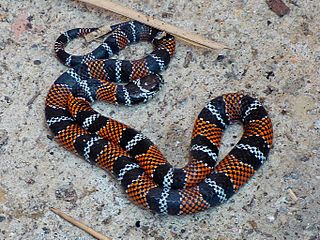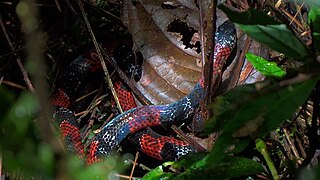
Cobra is the common name of various venomous snakes, most of which belong to the genus Naja.

Colubridae is a family of snakes. With 249 genera, it is the largest snake family. The earliest fossil species of the family date back to the Late Eocene epoch, with earlier origins suspected. Colubrid snakes are found on every continent except Antarctica.

Coral snakes are a large group of elapid snakes that can be divided into two distinct groups, the Old World coral snakes and New World coral snakes. There are 27 species of Old World coral snakes, in three genera, and 83 recognized species of New World coral snakes, in two genera. Genetic studies have found that the most basal lineages have origins in Asia, suggesting that the group originated in the Old World. While new world species of both genera are venomous, their bites are seldom lethal; only two confirmed fatalities have been documented in the past 100 years from the genus Micrurus. Meanwhile, snakes of the genus Micruroides have never caused a medically significant bite.

Trinidad and Tobago are continental islands with a geologically very recent history of direct land bridge connection to South America. As a result, unlike most of the Caribbean Islands, Trinidad and Tobago supports a primarily South American flora and fauna and has greater diversity of plant and animal species than the Antilles. However, rates of endemism are lower than in the rest of the Caribbean because there has been less time for genetic isolation from mainland populations because of the history of land bridge connections and hence fewer opportunities for speciation, and so a greater proportion of the species in Trinidad and Tobago are also found on the South American mainland. Trinidad is nearer to mainland South America and has been directly connected to the mainland via land bridges more often and for longer periods than Tobago. This, as well as Trinidad's larger size and more varied topography and hydrology compared to that of Tobago allow greater species and ecosystem diversity on the former compared to that on the later of the islands.

Oxyrhopus petolarius, commonly known as the forest flame snake, is a species of mildly venomous snake in the family Colubridae. The species is endemic to Central and South America. There are three recognized subspecies.
Erythrolamprus ocellatus, commonly known as the Tobago false coral snake, red snake, or doctor snake is a species of colubrid snake, which is endemic to the island of Tobago.

Erythrolamprus bizona, commonly known as the double-banded false coral snake, is a species of colubrid snake, which is found in northern South America and Central America.

Erythrolamprus aesculapii, also known commonly as the Aesculapian false coral snake, the South American false coral snake, and in Portuguese as bacorá, or falsa-coral, is a species of mildly venomous snake in the family Colubridae. The species is endemic to South America.
Puff adder is the common name of several snake species:

Xenodontinae is a subfamily of snakes in the family Colubridae.
Thunder-and-lightning snake may refer to:
False coral snake may refer to:

Erythrolamprus is a genus of colubrid snakes native to Central America, the Caribbean, and South America. They include the false coral snakes, which appear to be coral snake mimics.

Oxyrhopus, the false coral snakes, is a genus of colubrid snakes that belong to the subfamily Dipsadinae. All 15 members of the genus are found in the northern part of South America, with the native range of the most widespread member, Oxyrhopus petolarius, extending into Central America and Trinidad and Tobago as well.

Oxyrhopus guibei is a species of snake in the family Colubridae. The species is endemic to South America. It is often called the false coral snake, but this common name can refer to any of a long list of other species, genera, and even entire families of snakes. Many nonvenomous snakes have evolved coloration that mimics that of venomous true coral snakes, a trait which helps them avoid predation.
The smooth snake is a species of non-venomous snake found in northern and central Europe.
Erythrolamprus guentheri, also known commonly as Günther's false coral snake, is a species of snake in the subfamily Dipsadinae of the family Colubridae. The species is native to Ecuador and Peru.

Erythrolamprus mimus, the mimic false coral snake, is a species of snake in the family Colubridae. The species is found in Honduras, Nicaragua, Costa Rica, Panama, Ecuador, Peru, and Colombia.
This page is based on this
Wikipedia article Text is available under the
CC BY-SA 4.0 license; additional terms may apply.
Images, videos and audio are available under their respective licenses.











